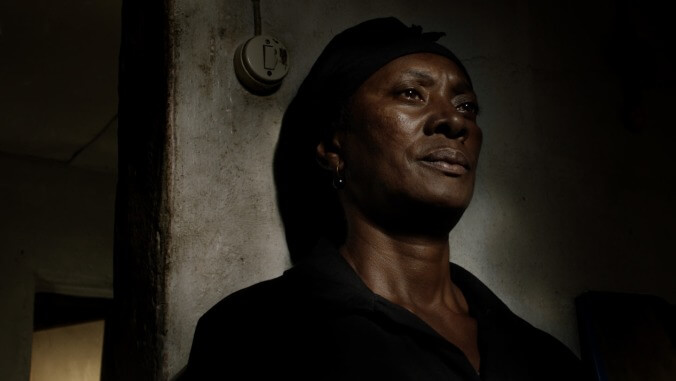But Cannes gave the film enough notoriety and vocal supporters to get it into Toronto and then into a run of mostly second- and third-tier film festivals, where screenings of Colossal Youth usually prompted an equal number of walkouts and conversions—the former group largely put off by the movie’s agonizing slowness and lack of typical arthouse niceties, the latter bowled over by its revelatory use of digital video and its aura of dreams and myth. For the newly minted Costa partisans, Colossal Youth seemed to at once call back to the mysteries of a much earlier cinema and to suggest some vision of a modern fable—the demolished Lisbon slum called Fontainhas and the figure of an aging Cape Verdean immigrant known only as Ventura, who wanders through memories of a lost home, addressing everyone as his children.
This is all to say that for a film that never found an American distributor or much interest in the mainstream press, Colossal Youth went a long way toward cementing Costa’s reputation as an important filmmaker. Part of it was the time. In the mid- to late-2000s, it was still possible for a movie to be appraised gradually. This was the era of longwinded blogs; the freaks and the print-media pros had found each other online, but the racing hype cycle of social media had not yet become the norm. When Colossal Youth had its brief run in Manhattan more than a year after Cannes, it was already considered a cinephile must-see; by the beginning of the next decade, it had been enshrined in a Criterion box set along with Ossos and In Vanda’s Room, the preceding features in Costa’s Fontainhas cycle. One inevitably looks back on those years with a degree of nostalgia.
Whatever may have changed over the course of a generation, Costa has continued working in the same mode of mythopoeic, anti-realist docufiction, even if the long-gone community of Fontainhas goes unmentioned in Vitalina Varela, his first film since Horse Money and the closest thing he’s made to a drama since Ossos. Within, one still finds the same crumbling concrete, dank rooms, and rust; the same world of passageways, doorways, and thresholds, implying some kind of liminal purgatory for Costa’s non-professional stars; the same striking visual compositions, which bring to mind black-and-white noirs, expressionist silent films, or the biblical paintings of Caravaggio.
Costa has never lacked intriguing influences, chiefly pre-1960s American masters like John Ford and Jacques Tourneur and European minimalists like Robert Bresson and the duo of Jean-Marie Straub and Danièle Huillet; the lattermost are also the subjects of his film Where Does Your Hidden Smile Lie?, which has a solid claim to being the best documentary about filmmaking made this century. Elsewhere, one discovers acknowledgments of artistic forebears like Jacob Riis, whose photographs of impoverished life in late 19th-century New York open Horse Money, and considerable post-punk loyalties, represented in the unlikely inclusion of a song by Wire in Ossos and in the English title of Colossal Youth (called Juventude Em Marcha, or Youth On The March, in Portuguese), which comes from the only studio album by the Welsh trio Young Marble Giants.
It is necessary to list these influences only to point out that Costa’s films, while sometimes impenetrable in terms of narrative and audience identification, have always had obvious heroes. If there is in fact a punk ethos thrumming through his work, it comes down to a refusal to betray certain principles. One suspects that he is at heart a romantic and an idealist. The romanticism is evident in the fairy tale qualities of his early films O Sangue and Casa De Lava and the abundance of metaphors for love and longing in the later ones, including Vitalina Varela. The idealism is there in his unconventional approach to making movies; in his fascination with the former Portuguese colony of Cape Verde; and his penchant for dignified portraiture.
Vitalina Varela, a middle-aged Cape Verdean who previously appeared in Horse Money, is herself a commanding presence. If Costa is to be believed, then the film that bears her name is loosely inspired by events in her life. It opens with a procession of men in funeral clothes through an unlit and almost medieval street, returning home to shanties of concrete and corrugated metal. Vitalina arrives on a plane, descends the gleaming airstair barefoot, and is cryptically met by a group of cleaning women. She has traveled to Portugal to bury her estranged husband, Joaquim, but has arrived too late, missing the funeral by three days. Her sadness and disappointment are palpable—a deep inner funk that grows in the darkness of every frame.
Visually speaking, Vitalina Varela will probably be the darkest movie to play in American theaters this year. Its decrepit and twisting spaces are swathed in shadows that suggest both the presence of phantoms and the starkness of a stage. Costa’s preference for static tableaux, combined with his own dabblings in installation art, might imply a gallery aesthetic, in which every shot is best appreciated as a still. But the surface quietudes, somnambulant movements, and rigors of a film like Vitalina Varela serve to turn every subtlety, every crinkling plastic bag and squeaky door, into a reverberating event.
This is perhaps the best way to explain the challenges of Costa’s style: It is an attempt to reclaim some of the profundity and lost magic of the medium. There is a parallel to be found in Costa’s dialogue, in which simple declarative sentences take on the qualities of poetry. His characters are lost in ruins and recitations, foggy memories and unfulfilled promises. We learn that Vitalina and Joaquim built a house together in Cape Verde in the 1980s, after which he disappeared; now she is the widow of a man she barely knew, staying in his unfinished home on the outskirts of Lisbon, which crumbles as though to mock her own faded dreams of domestic bliss. “You kept saying you would come, you would come,” she says, as though addressing the dead Joaquim. “And you died and never came.”
Like many of Costa’s films, Vitalina Varela is something of a ghost story, haunted by love and regret. There is nothing for Vitalina in Portugal, but having waited decades for a plane ticket, she is in no hurry to leave. Costa’s direction remains far removed from anything that passes for realistic; his actors move deliberately and slowly and almost never make eye contact. But there is nothing unrelatable about his protagonist’s wounded bitterness, which is revealed in long monologues. Costa, who never runs out of ways to frame Vitalina’s face, even gives her an uncharacteristic dramatic arc, eventually leading the film out of the dank, claustrophobic netherworld into daylight and flashbacks rendered in stupendous landscape shots.
His muse Ventura is there, too, cast as a meta character; he plays a clerygman who has lost his flock and now ministers to an abandoned church that looks suspiciously like a small movie theater. Which is about as close as Vitalina Varela comes to bluntly stating its themes: presence, absence, rekindled faith. One is reminded of the critic Jonathan Rosenbaum’s assertion circa Colossal Youth that Costa’s films are populated not by characters but by souls. Even in the film’s stretches of plutonic darkness, there is often a strange, painterly light shining down, catching glints in the eyes of people who never look at each other.



 Keep scrolling for more great stories from A.V. Club.
Keep scrolling for more great stories from A.V. Club.